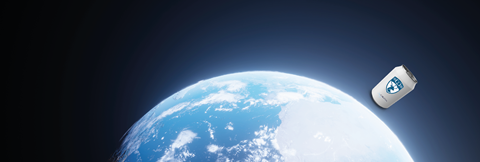Chelton sponsors University of Southampton team in International Satellite Competition

Marlow, UK: Chelton is proud to be sponsoring a team of engineering students from the University of Southampton (Soton) to compete in the American Astronautical Society’s CanSat competition. Demonstrating the UK’s capability, the team will design, build and launch a satellite for the American Astronautical Society’s competition with a catch; it must be the volume and shape of a soft drink can. During the competition, which takes place in June 2022, can sized satellites will be launched in a rocket to an altitude of around 1km before descending by a parachute.

The can sized satellite is required to fit all major subsystems into minimal volume, provide a parachute to ensure it survives landing, and transmit inflight data to an Earth-based computer back at base in Virginia. At present, the Soton team are in the final stages of design & development and will be working with a team of Chelton’s engineering and antenna experts during integration and testing to ensure the viability of the design using our state-of-the-art testing facilities.
Following a visit from the Soton CanSat team to the Chelton headquarters in Marlow, the students were shown our extensive testing facilities including our 11 anechoic chambers and vibration, temperature and humidity test facilities.
“Not only is this a fantastic opportunity for Chelton to expand into the world of space, it also allows us to provide these promising engineering students with access to our knowledge, skills and advanced testing facilities.”
"We are delighted to partner with the University of Southampton and some of their talented students on such an exciting project. We look forward to sharing our expertise and mentoring the engineers of tomorrow throughout the competition and beyond.”
Team University of Southampton’s (UoS) CanSat design is now fully functional and flight ready for the competition. They have managed to perform several simulated flights, in which the CanSat performed flawlessly.
After speaking with Chelton's engineers, the team were successfully able to reduce the mass of the CanSat using acetate sheets in place of redundant structural parts and implemented release mechanisms for the Payload and parachute.
The CanSat releases the parachute and payload at the correct simulated altitude even under significant stresses applied by the team on the cords connecting them. Communication with the ground station is also fully functional and has been tested extensively with their Xbee radios and Yagi antenna.
The cameras and the mirror system are also operational and the team will hopefully be able to share some footage of the flight from the CanSat’s perspective! The mirror system has been an area of the project which the team have discussed extensively with Chelton and the team are grateful to the engineers involved for all their advice and input who have helped enable them to develop a very elegant and effective solution to keep the Payload camera pointing in the south direction.
Team UoS did face an issue with the GPS, in which it would take several minutes to obtain a satellite fix, but once found, maintains and transmits coordinates to the ground station along with the rest of the sensors. However, the team believe this should not be an issue on the day as they will have plenty of time to setup the CanSat before launch and enough battery power for the CanSat to be powered on most of the day.
The team are very faithful in their final design and confident this will show through results of the competition!
The team express how invaluable the testing visits have been at Chelton as it allowed them to identify significant areas that needed improvement. Laura Pearson, head of sponsorship and media for the team believes “with Chelton’s help we have now developed a very compliant and robust system.”
Wishing the UoS team the best of luck with their competition!

Adrian is in his final year at university, studying Electronic engineering with Industrial Studies. Adrian took an interest in this course due to his ambition to work on real-life applications and help push the boundaries of technological advancement. Adrian is hoping to carry their success from last year’s national CanSat competition to this year’s international stage in the competition.

Dimitrios is in his second year, studying Electrical and Electronic Engineering. Dimitrios path into engineering followed the route of his desire to learn how the world works and disassembling things to find out what makes them tick. Dimitrios received a very STEM-oriented education which infused his thought process of an engineer. He said “The deal was sealed in my teenage years when I started getting into electronics and programming. I made the decision to turn my hobby into a degree and hopefully a profession.”

Laura is in her third year, studying Spacecraft Engineering. Laura has always enjoyed maths and sciences, and growing up, she found herself watching the launches to the ISS. Laura found herself fascinated by how complex spacecraft appeared to be.

Pedro is also in his third year, studying Spacecraft Engineering. Pedro was engrossed by this course due to his interest in space, and figuring out how things work. He took an interest in the CanSat competition as it seemed challenging, and he felt that it was a great chance to learn and get involved with an engineering project outside of University.

Laura is in the first year at university, studying Electronic Engineering with Industrial Studies. This course enticed Laura as she felt "we are living in an era of incredible growth" where this degree will not only provide her with the skills for future inventions, but also the knowledge to modify current designs. She states the team are “thrilled about the level of support Chelton is providing, which is vital to our project's success."

Thomas is in his second year, studying Computer Science with Cyber Security. This course took Thomas’ interest due to his interest in the cyber security field. With the increasing use and reliance on technology in the modern world, Thomas believes that security is a key factor in helping to protect people and organisations.

Mia is in her second year, studying Physics with Astrophysics. Mia choose Physics as she wanted to study the fundamental principles that the engineering disciplines are based on. She likes learning about where concepts come from and how they are first derived, as well as how to apply them. Mia has also been fascinated by space from a very young age, and believes that with physics, she is able to learn, not just about the laws of nature that must be applied in order to send satellites into space, but also what the satellites will measure once they’re there.

Harold is in his third year, studying Aerospace Electronic Engineering. During secondary school, Harold particularly enjoyed the Electronic Products in GCSE which included mini projects to design, produce and test electronic circuits with a theoretical, physics background. His primary interest in aerospace systems and his want to learn more about the theory of electronics, helped him decide on his degree he wanted to study at university.

Nicholas is in his third year, studying Spacecraft Engineering. Nicholas says that he has “always been quite obsessed with engineering, or at least I can't remember when I wasn't.” The idea of solving problems and doing things we could never do before fascinated Nicholas.
Oliver is in his second year, studying Aerospace Electronic Engineering with Industrial Studies. He has always showed eagerness towards how small devices and other man-made vehicles and mechanisms work. Since a young age Oliver has enjoyed designing circuits and systems, which have all led him to focus his studies in communication systems and aerospace vehicles.
Your quote basket is currently empty
 Please select the type of quote you require for this product:
Please select the type of quote you require for this product: